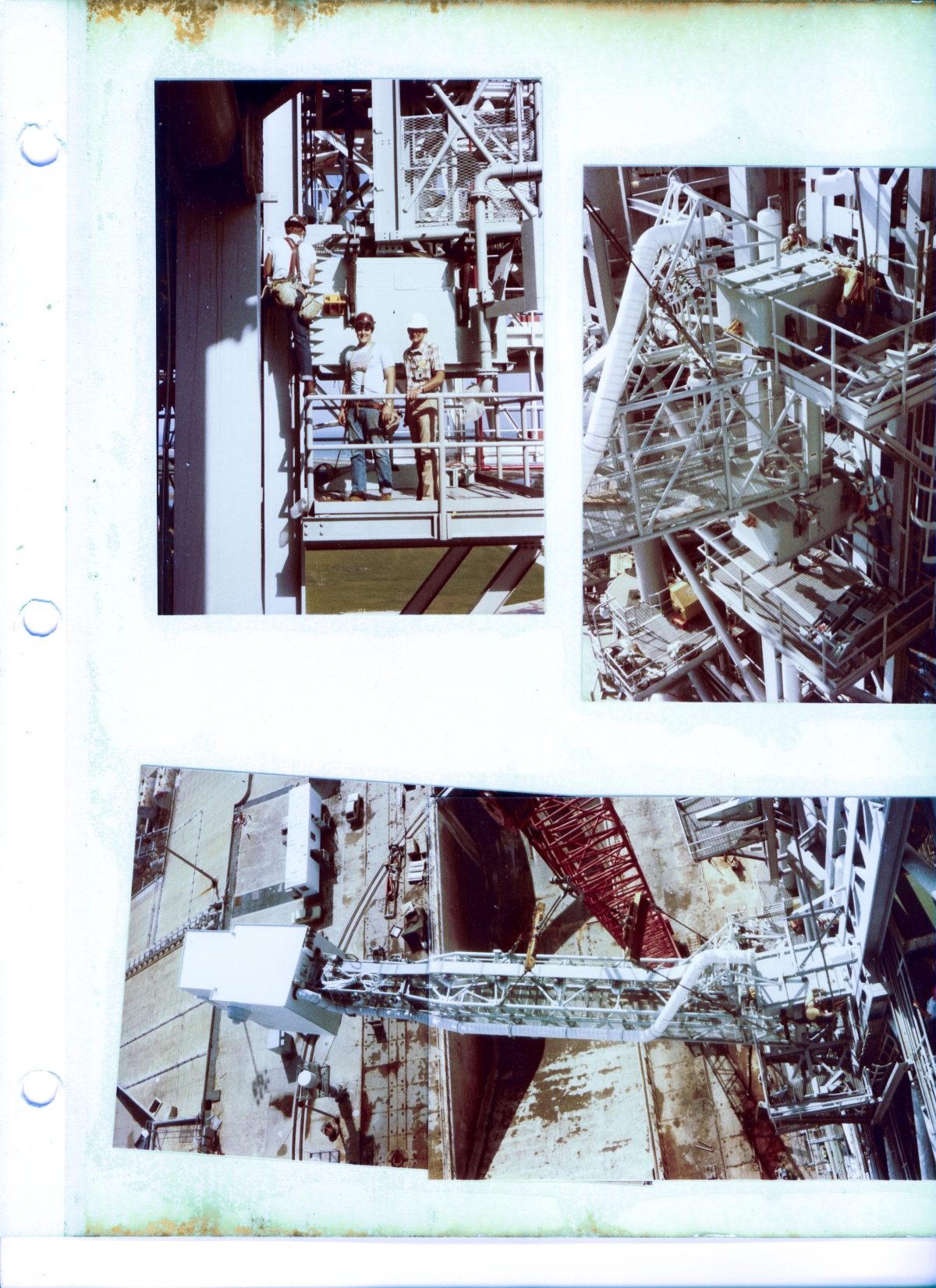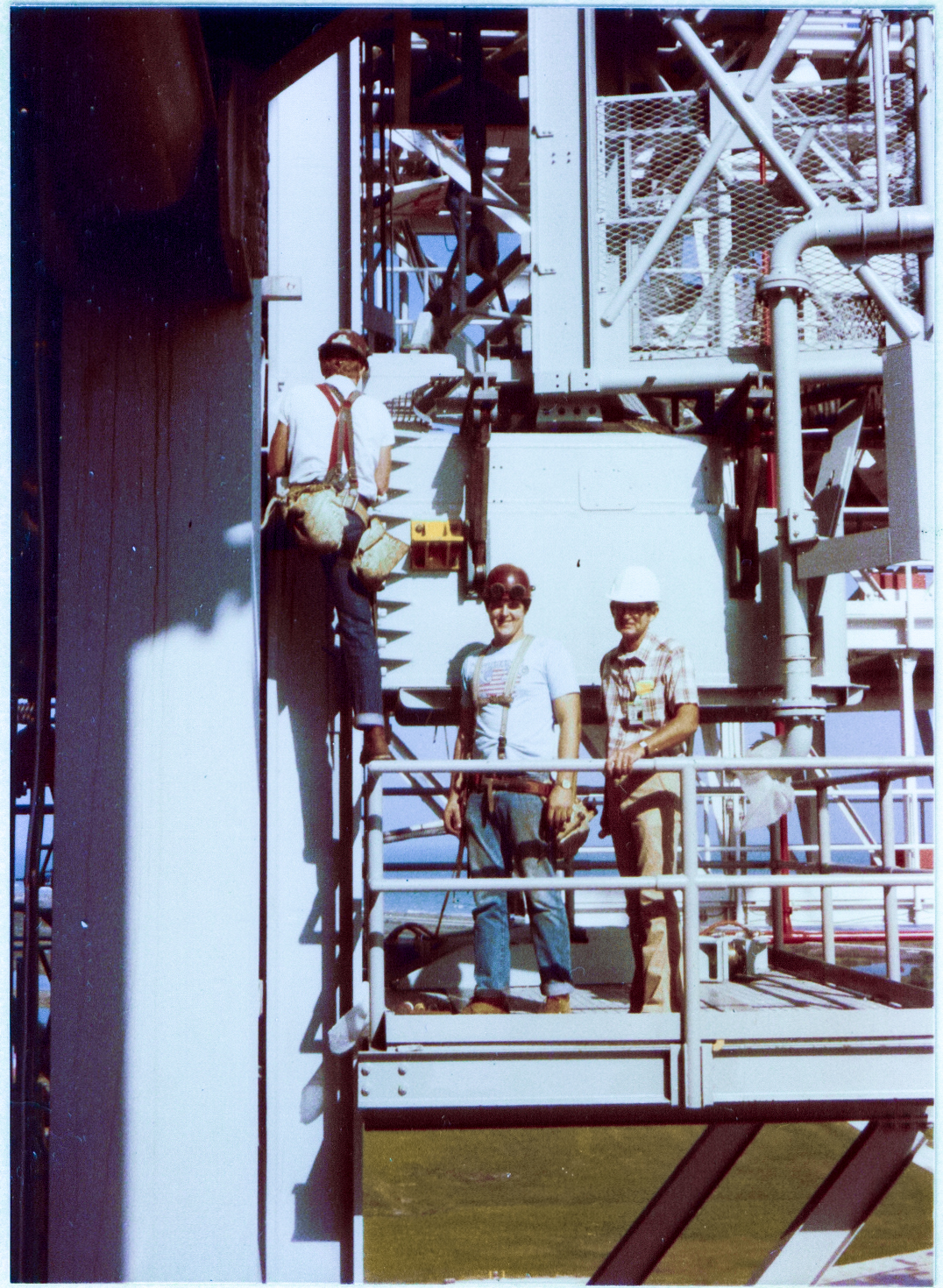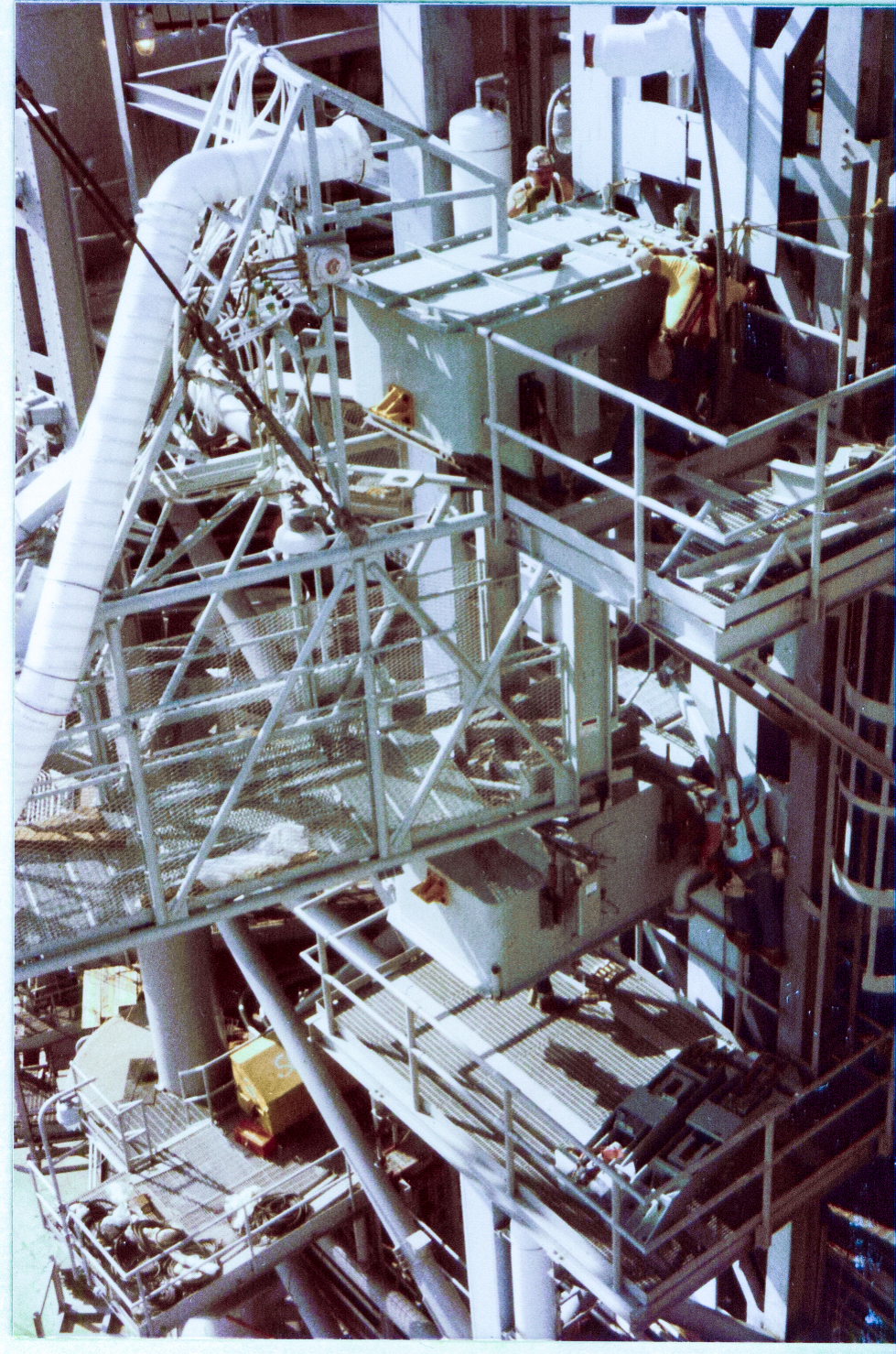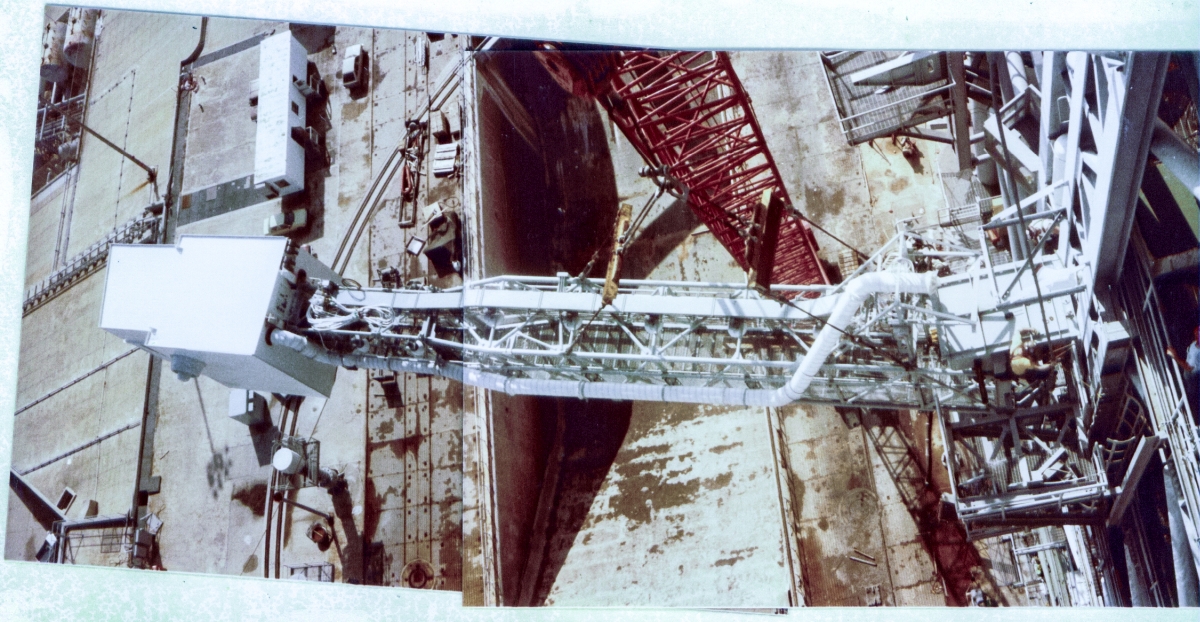Space Shuttle Launch Complex 39-B Construction Photos
Page 23
OAA Lift 3
(Original Scan)
Fastening the OAA to the FSS using outrageously expensive aircraft bolts that cost us a bundle, and did not make a lick of sense, as the structure upon which the OAA was fastened to, was itself assembled with plain old garden-variety A325 high-strength structural bolts, and they seemed to be holding all of the rest of the tower together just fine without any help from the aircraft industry. Some of those bolts (just the bolt, not the nut or washer) cost upwards of a hundred bucks apiece(!) and this was back in the 80's when a hundred bucks was actually worth a little something.
Oh well.
Top left photo is Wade Ivey (white hard-hat facing camera) and his son Kevin (brown hard-hat facing camera) on the OAA Lower Hinge Access Platform. I'm not sure about Wade, but I think Kevin is still running Ivey Construction.
These are the guys who build the launch pads, in case you were wondering.
Additional commentary below the image.

Top Left:
(Full-size)

As one of their ironworkers goes about the business of finishing off the installation of the (pointlessly, needlessly, and ridiculously, expensive) bolts that attaches the lower OAA hinge to the FSS, Wade Ivey (right), and his son Kevin (center), turn, take just a few seconds from the never-ending focus required to watch over things and keep them going, and give me a pleasant look as I aim at them with the camera from the vantage point of the OAA Latchback access platform, which you reached by climbing up a ladder from the south side of the FSS at elevation 180' which took you to a catwalk at elevation 187' which accessed the Orbiter Access Arm Support Columns, that then took you to another ladder, which then took you to the platform (which is, alas, not shown in the drawings I am forced to work with here) and which platform can just barely be picked out of the welter of steel framing, just to the right and below the round framing of the top hinge access platform on the hinge column, and is partly obscured by the red latticework of the crane boom, when you zoom way the hell in on things at high magnification in this picture. Just another one of those nondescript little platforms that both towers were just riddled with. Zoom in close on any of the large "overview" images and start looking around for these things and you'll soon find yourself discovering them everywhere. Most folks have no idea the extent to which there are little walkways, mezzanine-level landings, stairs, caged-ladders, platforms, steel bar grating, handrails, safety chains, and support framing all over the place on both towers. The place was a deeply-complex labyrinth, in every sense of the word. And I'd be lying through my teeth if I said I did not very much enjoy knowing the whole thing like the back of my hand.
Getting shots of people with any kind of pleasant look on their faces out on this job was a highly difficult thing to do, and I take pride in having gotten as many of them as I did.
In a culture such as this one, nobody wants to "pose" or be seen as anything other than a no-nonsense agent of getting the work done, and anything that so much as smelled of anything else was generally belittled, attacked, derided, and otherwise frowned upon deeply by all of the participants with very few exceptions.
But every once in a while, I found myself able to momentarily charm a person or two into a kindly look or an actual smile, and when those rare moments came along, unexpectedly for the most part, I seized them instantly, hit the shutter release, and hoped that the goddamned resulting image would come out.
As I've said earlier, it's always better to be lucky than smart, right?
Top Right:
(Full -size)

As viewed from the vantage point of the IAA, we can see ironworkers going at it on both hinges, securing the OAA to the FSS.
At top right, an ironworker in a yellow shirt with his back to us is reaching into the shadows of the strongback truss, doing what, I cannot say. Notice please that the steel-bar grating on the upper hinge access platform he's standing upon has been removed in order to get this work done, and he's working with his boots on bare-iron framing steel. If he were to slip and fall (they never did, but still...), his fall would be stopped by the lower hinge access platform, a mere twenty or so feet below him, which might at first seem like a not so unreasonable thing. A fall of this height would not ordinarily be expected to be lethal (although it could, too), but even the most casual glance at this image, with the zoom up near 200 percent, reveals a horrifying welter of things with terrifyingly hard edges in no end of unpleasant locations, and if a fall was taken, a stay in the hospital for weeks, or perhaps even months could be expected, and full recovery such that he could return to work would be very much in doubt. Maybe while you're falling, you reflexively reach out to grab something to stop the fall and only come away with some of the loose iron piled up there right next to the hole, and have that raining down on you too. These people put it on the line, in ways that everyone else can never so much as conceive of, every day. Everybody says that ironworkers have an attitude, and I fully agree with that. And you know what? That fucking attitude was fully-justified. Completely justifiable in every way. These guys know exactly who they are and exactly what they do, and they also know that you are not, and can not, so how 'bout you go ahead and have yourself another nice drink of shut the fuck up and leave me the fuck alone, and get the hell out of my way while you're doing it, hmm?
Bottom:
(Reduced)

Looking down on things from the lower Gox Arm hinge access platform, at elevation 263'-4".
One of the problems with taking pictures of this work consisted in choosing the right place to take the picture from.
There were just too damn many of them, and time was always short, and nothing ever stood still, and the place was big enough that it could take a respectable bit of time to get from here to there, and if here didn't give you the good angle you thought it would, then you could only hope that you could get there before whatever it was that you were trying to get a shot of disappeared forever.
And I was utterly on my own with this stuff.
Nobody else gave a shit about any of what I was doing with the camera. Not one single person. Which might tell us a little bit about the people you may expect to encounter in places like this, too.
This is another one of those shots that I really like. It gives you a really good look at the layout of the OAA, and as seen here, it is in its fully-extended position.
Notice, if you will, that the white room on the end of the OAA isn't quite properly rectangular. Instead, it's a right-trapezoid (ignoring the bit where it narrows down some on the orbiter side of things), and the angle of the side of the room that connects to the rest of the OAA differs from the angle of its opposite side, which directly abuts the Space Shuttle when the arm is extended. This is because the OAA hinges are not attached to the FSS directly straight across from the crew hatch on the orbiter, and the arm, as a result, meets the orbiter at a noticeable angle. The arm never quite extends ninety full degrees when it's being extended. It meets the Shuttle before it ever gets that far, and as a result, the far end of the white room away from the FSS sits at a different angle to the near end, in order to allow it to properly and closely match the angle of the orbiter crew cabin where it's doing its work.
Little stuff. I never grow tired of learning about the little stuff.
The OAA latchback access platform that I took the picture (top left image on this page) of Wade and Kevin from, can be seen plainly, extending down from along the top right margin of this picture, to the right of the crane boom. You can also see the support skid upon which the OAA would come to rest in its retracted position, where it would be latched back to the main structure when not in use, to keep it from getting knocked around too much by either rough weather (this is hurricane country, remember), or the exhaust plume from the Space Shuttle when it took off.
And we're getting a pretty good look at the bottom of the flame trench, past the toe of the flame deflector, two-hundred some-odd feet below you, too.
Now stop a minute, and consider that group of women and men, boots clanking across the steel bar grating panels, walking out along this flimsy-looking open-air bridge across a yawning gulf of over fifty meters, preparing to enter a gigantic hissing, fuming, living thing, possessed of the energy of a small atomic bomb, entrusting their lives to it, getting ready to ride it as if they were riding a fire-breathing dragon, permitting it to take them to a place with no air to breathe, ten times faster than a rifle bullet, with no way out should things go badly wrong.
Really? Is this really what you guys are getting ready to do today?
Like I said earlier, the OAA has the power to make you stop. And think. And consider. And maybe shiver a little bit, too.
Return to 16streets.comACRONYMS LOOK-UP PAGEMaybe try to email me? |